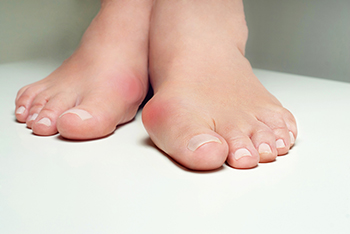Dealing With a Bunion
Thursday, 07 April 2022 00:00A bunion is a bony protrusion of the foot, caused when the big toe pushes inward toward the other toes, and the head of the metatarsal below it pushes outward. This deformity, called hallux valgus, can become quite painful, because the bump that is formed rubs against the side of the shoe, becoming red and sore. Bunions also negatively affect how you walk and distribute your weight, and can cause other painful conditions, like metatarsalgia (pain in the ball of the foot), and hammertoe. Common causes for bunions include wearing shoes and socks that do not allow for proper movement in the toe box, wearing high heels with pointy toes, and genetics. Several pads and braces are available over the counter to help ease the pain of bunions and temporarily straighten the toe. But as a rule, once a bunion is formed, the toe will not straighten out on its own. In the end, surgery is the most realistic treatment option, and even then, your toe may never be perfectly straight. If you have a bunion that is interfering with the activities in your life, it is suggested that you see a podiatrist for an examination and treatment plan.
If you are suffering from bunion pain, contact Dr. Eugenio Rivera of Calo Foot & Ankle Specialists. Our doctor can provide the care you need to keep you pain-free and on your feet.
What Is a Bunion?
Bunions are painful bony bumps that usually develop on the inside of the foot at the joint of the big toe. As the deformity increases over time, it may become painful to walk and wear shoes. Women are more likely to exacerbate existing bunions since they often wear tight, narrow shoes that shift their toes together. Bunion pain can be relieved by wearing wider shoes with enough room for the toes.
Causes
- Genetics – some people inherit feet that are more prone to bunion development
- Inflammatory Conditions - rheumatoid arthritis and polio may cause bunion development
Symptoms
- Redness and inflammation
- Pain and tenderness
- Callus or corns on the bump
- Restricted motion in the big toe
In order to diagnose your bunion, your podiatrist may ask about your medical history, symptoms, and general health. Your doctor might also order an x-ray to take a closer look at your feet. Nonsurgical treatment options include orthotics, padding, icing, changes in footwear, and medication. If nonsurgical treatments don’t alleviate your bunion pain, surgery may be necessary.
If you have any questions, please feel free to contact our office located in Bellaire, TX . We offer the newest diagnostic and treatment technologies for all your foot care needs.










